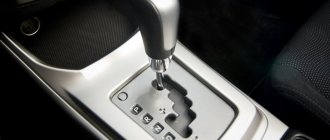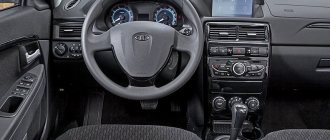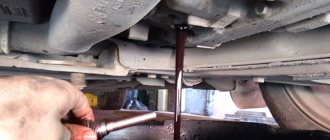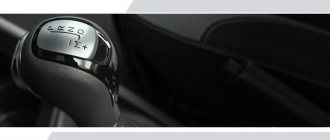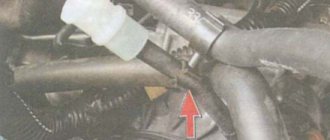Passenger cars use several types of stepped transmissions that provide manual or automatic gear shifting. On some cars there is a robotic gearbox, created on the basis of a mechanical one, but with automatic gear shifting and clutch control. The driver needs to know how to drive a robot, since the life of the clutch and the mechanical part of the gearbox depends on proper operation.
Robotic gearboxes are quite popular these days.
Robotic gearbox
Beginning car owners often do not understand what a robot is and how it differs from a regular automatic machine. The fact is that a manual transmission is essentially a manual transmission, which is controlled by an electronic unit.
A robotic gearbox, unlike an automatic transmission, is divided into two more subtypes:
- Mechanical gearbox with electronic unit or simple robot. This type was the first to be developed, so it had many negative aspects. It came to the point that there were long time intervals between gear shifts in the car’s automatic transmission. The driver felt these dips as eternal twitches and jolts during acceleration.
- The same box with only two clutch systems or preselective. This is a more advanced first type of manual transmission. Installed on racing vehicles. Two clutch shafts allow you to change gears while the previous gear is in operation.
Attention! At the very beginning, the robot began to be produced as a replacement for an automatic machine, to reduce car owners’ repair costs. And budget cars have electric servos, while expensive and sports cars have hydraulic ones.. Budget options for robots with the second type are not very successful
For example, in Opel or Ford with manual transmission, manufacturers replaced hydraulic pumps with stepper motors. As a result, the driver constantly feels jerks and delays in switching. Although, experts noted that a similar robot is installed on the same Toyota Corolla, but these disadvantages are absent
Budget options for robots with the second type are not very successful. For example, in Opel or Ford with manual transmission, manufacturers replaced hydraulic pumps with stepper motors. As a result, the driver constantly feels jerks and delays in switching. Although, experts noted that a similar robot is installed on the same Toyota Corolla, but these disadvantages are absent.
Manual transmission design
The design difference between a robot and an automatic machine is as follows:
- two mechanical shafts that are located inside each other. Each of them has its own clutch;
- actuator or servo: electric or hydraulic. When using the first, all executive commands are executed by servomechanisms. If a hydromechanical block is present, it acts as a clutch. If a hydraulic drive is installed, it is controlled by hydraulic cylinders, which, in turn, are controlled by solenoid valves;
- the electronic unit. This system controls the execution mechanisms and monitors the robot's gearbox sensors. It is combined with the on-board computer.
Unlike an automatic transmission, gears shift faster in a robot. For example, on a DSG from Volkswagen, the gear change occurs in one hundredth of a second.
You can distinguish a robot from an automatic machine by the advantages that its use provides and the negative sides.
Advantages and disadvantages
Robots installed in machines have the following advantages:
- easy to maintain;
- economical consumption of lubricating fluid due to the absence of a hydraulic converter;
- instant speed switching;
- low fuel consumption;
- high dynamics.
- poor quality smooth gear shifting;
- the driver feels delays when changing speeds;
- unpredictability in behavior under difficult road conditions;
- transition to neutral at every stop;
- The robot's lifespan decreases with each slip.
Experts note that constant movement with slipping leads to wear not only of the robot, but also of the engine. Therefore, manual transmissions are most intended for urban traffic.
Hydromechanical automatic transmission, or “regular automatic”
In order not to control the gearbox “hand-to-hand”, and not to strain your arms and legs too much in dense city traffic, an automatic transmission was invented. First, a hydromechanical automatic transmission (automatic transmission) appeared. In order to understand how it works, you need... a fan (regular, household) and some kind of children's spinner-toy with a propeller-screw similar to a fan. Turn on the fan and bring this toy to it. What will happen? The propeller on the toy will also spin! Now imagine that the propeller is driven not by an electric fan motor, but by a car engine. And the second screw is located on the shaft, which goes into the “black box” with gears, couplings, and everything else. Both of these propellers are housed in a sealed housing filled with a special transmission fluid called a torque converter. What are these passions for? And in order to move off smoothly, change gears as smoothly as possible without any clutch “from the driver’s foot,” as in a “mechanics” between the engine and the “black box” with gears. After all, in order to get going, you need to smoothly connect the motor and the “black box” of the box. This is what the torque converter does, without losing any effort from the engine. And liquid is needed in order to transmit rotational motion through it. Otherwise he won't be able to cope with the air. The air density is low to transfer energy at such rotational speeds. As for gear changes, they are performed at the command of the control unit, automatically, depending on driving conditions. Previously, these blocks were hydraulic, now they are electronic. In general, everything seems to be good in the hydromechanical automatic transmission. It drives on its own, it shifts on its own. The driver can only press the gas and brake pedals and click the automatic selector between “Parking”, “Drive” and “Back”. Moreover, this thing works quite reliably. If you don’t pretend to be Schumacher with an automatic transmission, and follow the Maintenance Regulations, then it won’t break down. But there are disadvantages. The main ones are the noticeable moments of automatic automatic transmission range switching in a “black box” with gears, and higher fuel consumption compared to “mechanics” with the same power units. The need for greater comfort, rising fuel prices and environmental concerns encouraged engineers to think again about automation.
The design and principle of operation of a robotic gearbox with one clutch
Robot with hydraulic gear shifting
The robotic gearbox can be with one or two clutches. A robot with two clutches can be found in the article about Powershift. We will continue talking about a single-clutch gearbox.
The robot's design is quite simple and includes the following elements:
- mechanical part;
- clutch;
- drives;
- control system.
The mechanical part contains all the components of conventional mechanics, and the operating principle of a robotic automatic transmission is similar to the operating principle of a manual transmission.
The drives that control the box can be hydraulic or electric. In this case, one of the drives monitors the clutch and is responsible for turning it on and off. The second controls the gear shift mechanism. Practice has shown that a hydraulically driven gearbox functions better. As a rule, such a box is used on more expensive cars.
The robotic gearbox also has a manual gear shift mode. This is its uniqueness - both a robot and a person can change gears.
The control system is electronic and includes the following parts:
- input sensors;
- electronic control unit;
- actuators (actuators).
Scheme of operation of manual transmission
Input sensors monitor the main parameters of the gearbox operation. These include speed, fork and selector position, pressure level and oil temperature. All data is transmitted to the control unit, which controls the actuators. The actuator, in turn, controls using servos.
In a hydraulic automatic transmission, the control system is additionally equipped with a hydraulic control unit. It controls the operation of hydraulic cylinders.
The robot operates in two ways: automatic and semi-automatic. In the first case, the box is controlled through a specific algorithm, which is set by the control unit based on sensor signals. In the second, the operating principle is identical to manual gear shifting. Gears are sequentially switched from high to low using the selector lever, and vice versa.
Sudden change in speed
The DSG robot with a double clutch works as follows: one clutch is responsible for even gears, the other for odd ones. The electronics adapt to the driver’s driving style, switch on the desired speed in advance, and then simply engage the clutch at the right time. Accordingly, if you press the gas, the transmission prepares to engage an upshift, and if you brake, it prepares to engage a downshift. When driving aggressively with sharp braking after acceleration and vice versa, the automatic system does not have time to select the desired speed and changes gears in emergency mode. This leads to impacts on the clutch disc, damage to it and a reduction in service life.
If you want to thrill your nerves, choose the manual gearshift mode. This will allow you to choose the correct speed even with sudden changes in speed and not mislead the automatic system, which is tuned to a comfortable, predictable driving style.
Malfunctions of the robotic transmission
Often, various signs can serve as a reason for repairs. Among them, it is worth highlighting the spontaneous switching of the box to neutral mode. Fortunately, this behavior is typical for cars with already high mileage - 200 thousand km or a little more. In this case, the symptom manifests itself regardless of the box modes.
In some cases, drivers may feel jerking when starting the car. If such a symptom is observed in Nissan or Toyota cars, then it means it’s time to replace the clutch driven disc.
As practice shows, most often the clutch assembly fails in a manual transmission. Only Toyota cars are an exception - actuators have to be changed in robotic mechanisms. In addition, a nuisance may arise in the form of bearing wear. In this case, you will have to change all the clutch parts, or even the entire body. After repair, the box is again ready to serve for another 200 thousand km.
How does a robotic gearbox work?
How does a “robot” differ from a “automatic machine”? At least with your device. “Robots” can also differ from each other. However, these nodes have something in common. This is a manual transmission where the shifting and clutch are controlled electronically. In such solutions, a friction clutch system is used.
Weight Features
The weight of the box is quite an important issue. In this parameter, the transmission performs better than the automatic, since it is much lighter. The curb weight of such a box for passenger cars will be no more than 50 kg, while the weight of an automatic transmission only starts from this mark and reaches 100 kg in maximum positions. Accordingly, with a robot the car will be lighter, that is, the shock absorbers, wheels and engine do not experience heavy load.
What is the difference between a robot and a machine gun?
To understand the difference between an automatic transmission and a robot, it is worth understanding the operating principle of each of these transmissions and the design of the system as a whole.
Design and operating principle of automatic transmission
The automation is based on a control system, a torque converter and a planetary type gearbox with specific gears and clutches. Thanks to this design, speeds are switched autonomously without driver intervention. The guideline in this case is such parameters as driving mode, load and engine speed.
The relevance of installing the machine is observed on trucks and cars, as well as buses. If the car is front-wheel drive, the automatic transmission design is complemented by a differential and final drive.
Design and principle of operation of manual transmission
The first thing that distinguishes a robot from an automatic transmission is its special design, which combines the capabilities of a manual and automatic transmission. In fact, the mechanics in this case are supplemented by automatic control with actuators that are responsible for shifting gears and operating the clutch. Shifting occurs in the same way as with a manual transmission, but the driver is not involved.
The primary goal of creating a robotic gearbox was to reduce the cost of the transmission and simultaneously combine all the advantages of manual and automatic gearboxes. It's all about ease of use and comfort. As a result, there are several options for designing the system.
- Using the example of BMW M series cars, we can consider the highest quality and well-known manual transmission called Sequental M Gearbox (SMG). The gearbox is a 6-speed manual, with electronically controlled hydraulics responsible for shifting gears and disengaging the clutch. Gears change in 0.08 seconds.
- Using the example of the Mercedes-Benz A-Class, we can consider another principle, where the electro-hydraulic clutch drive is installed on a mechanical basis. The driver participates in changing gears, but there are only two pedals. The electric drive independently monitors the position of the lever and gas pedal, so in this case there is no clutch and it disengages automatically. The numbers on the ABS and engine sensors help the electronics make calculations to avoid shifting jerks and abrupt engine stops.
- Using the example of Ford and Opel cars, we can consider the third principle, where hydraulic pumps are replaced by stepper motors. Despite the budgetary nature of this option, in practice it turned out to be not very successful, which is reflected in a delay in switching gears and strong jerks. However, the Toyota Corolla has a similar transmission, and the disadvantages mentioned are not present here.
The main differences between automatic transmission and manual transmission
So, robotic and automatic transmission: what is the difference between these two transmissions?
- The first difference is in the design. In the case of a robot, it is a mechanic with a control unit, the automation device is completely different.
- The smoothness and speed of switching is better with automatics.
- Almost all automatic transmissions do not have a manual shift function, while robotic transmissions have this function.
- Another difference between a robot and an automatic machine is the cost-effective repair and maintenance of the former.
- Savings are also reflected in the fact that the robot consumes less oil and fuel.
General recommendations
We have looked at how to drive a robotic gearbox correctly, now we will give some practical advice:
- At the start, you should not squeeze the gas; when you need to increase speed, you should press the pedal confidently, but smoothly.
- It is better to carry out initialization at a service center several times a year - this will minimize jerking and jerking.
- When accelerating, follow the logic of the manual transmission.
The last thing that can be added about robotic and CVT gearboxes is the manual control mode or the so-called tiptronic. It is implemented by moving the gear selection lever into a special additional groove, indicated by the signs “+” and “-” for upshifting and downshifting, respectively, and you can find out more about this gearbox option in our material. In general, we can say that, even despite the variety of nuances in controlling a CVT and a robot, with some driving experience, habits and skills are developed that greatly help in the process of driving a car. Following our advice and the above rules will help to significantly extend the life of the gearbox and the entire car.
“>
Operating principle of a robotic gearbox
Manual transmission has the same operating principle as a manual transmission. It has the same three shafts: driven, intermediate and driving, the same gears and gear ratios. As mentioned above, robots are controlled by servos, otherwise known as actuators. These devices engage and disengage the shaft gears, and also connect and disconnect the box with the engine flywheel. Control over the process was taken over by an electronic unit that sends commands to a hydraulic drive or electric motor. Based on the input sensor signals, the block generates a control algorithm that depends on external conditions, and implements it through actuators. All the driver can do is use the paddle selector to change gears.
Automatic transmission with torque converter
What is a robotic gearbox?
A robotic gearbox on a car means something between a manual transmission and an automatic transmission. In fact, a robotic gearbox is a “mechanics” equipped with an automatic clutch and the ability to change gears. The operation of this type of unit does not depend on the driver, but on the functioning of the control electronic module. While driving, the driver only needs to correctly transmit incoming data to ensure proper operation of the gearbox.
Before buying a car with such a unit, it is recommended to understand the basic characteristics and operating principle of the device.
Robotic gearbox device
Schematic structure of the structural components of manual transmission
To understand what it is, you need to understand the structure of the unit. Additional elements intended for squeezing the clutch, as well as switching and selecting speeds, are called actuators.
The robotic transmission is equipped with its own control system, made in the form of a control unit, as well as several controllers. These sensors are designed to interact with the block. A robotic gearbox is fundamentally different from traditional automatic transmissions and CVT transmissions.
Robot gearboxes, like mechanical ones, are equipped with a clutch. ATF gear oils are not used in these types of units.
Depending on the car manufacturer, the robotic transmission can be equipped with one or two clutches:
- if there is only one clutch, then it is a single-disk unit;
- if two, then the transmission is considered preselective.
The main components of the robotic unit:
- The checkpoint itself.
- Actuators or servos. Designed for squeezing the clutch and activating speeds.
- The control module, which is a microprocessor unit. Used to process and transmit commands.
- External controllers. The number of sensors may vary depending on the machine manufacturer.
checkpoint
We recommend understanding the structure of the robotic unit in more detail using the example of a six-speed gearbox equipped with two clutches. The unit is designed as a manual gearbox, but is equipped with two drive pulleys. One of these elements is installed inside the other. The outer pulley has an internal cavity into which the inner component is installed. The outer pulley contains the gears for driving the second, fourth and sixth speeds, and the inner pulley contains the gears for the first, third, fifth and reverse gears.
Each shaft of the robotic gearbox is equipped with a separate clutch.
Actuators or servos
Actuator devices can be electrical or hydraulic. The electric type of elements is made in the form of an electric motor with a gearbox, and the hydraulic type is considered a hydraulic cylinder. The rod of the latter is connected to the synchronizer device. The main purpose of the actuator elements is to mechanically move the synchronizer components, as well as activate and deactivate the clutch.
Control module
The control module is a microprocessor unit on which external controllers are installed. These sensors are involved in the electronic engine control system of the machine. The transmission sensor interacts with controllers from the power unit and other systems, for example, ABS. The control module can be combined with a microprocessor engine control unit, but the transmission will operate according to its own algorithm.
The Carvizor channel spoke in detail about the structure and design features of manual transmission.
Features of a robotic gearbox
The electric clutch drive operates via an electric motor as well as mechanical speed. The operation of the hydraulic drive is based on special cylindrical devices, which are controlled by an electromagnetic valve. Sometimes a robotic unit can be supplemented with an electric motor, which is used to move cylindrical elements and is designed to support the functioning of the hydromechanical module. This device, equipped with a drive, is characterized by a long speed switching, which can be up to half a second.
Compared to a hydraulic device, the unit does not require constant support of the required pressure level to operate. In some Opel models, hydraulic units are characterized by a fast speed switching cycle, providing switching in 0.06 seconds. But such robots are usually installed on sports cars.
Other modes
These are the basic rules on how to operate a robotic box. But there are other features, for example, some manual transmissions have additional modes - sport and winter, the so-called “snowflake”.
“Snowflake” is aimed at starting movement on an icy road as smoothly and without slipping as possible. All it does is ensure that the car starts straight from second gear and makes upshifts smoother.
The “sport” mode switches to higher gears at higher speeds than in normal mode. This allows you to accelerate faster. That is, if in normal mode the transition to 2nd gear was performed, for example, at 2500 rpm, then in the “sport” mode this transition will be carried out at 3000 rpm.
Now about the possibility of switching from automatic to manual mode and back while driving. The robotic box allows you to do this without any problems. It is also possible to independently downshift or upshift to change the speed of movement. But it is worth considering that the electronic unit will not completely transfer control of the box; it will constantly monitor the operation.
Therefore, if the driver decides to shift, for example, down two gears, then the electronic unit will allow this to be done, but at the same time it will control the engine speed and if they do not correspond to the selected gear, the electronics will independently switch to an acceptable gear - the so-called “protection against fool."
Everything is simple here - the electronic unit is programmed so that each gear corresponds to a certain engine speed range. And if the manually selected gear corresponds to its range, the box will switch, and if not, it will switch on the required speed.
Urban conditions/stop, parking
There are opinions that the robot box gets along less well in city conditions with traffic jams, and this shortens its service life. Advice: after stopping the car completely, the selector must be set to neutral mode “N”, put on the handbrake and then turn off the engine. If the stops are short-term, then there is no need to switch the selector to neutral mode; be in position “A”. Since the clutch remains depressed when stopping, it is better to turn off the engine during traffic jams or traffic lights with a delay of more than a minute.
Do you need to warm up your car in winter?
How to control a robotic gearbox? First you need to decide whether there is a need to warm up the box before using it in winter. If you use an automatic device, then you know that in cold weather you cannot do without pre-warming, which is done by briefly moving the selector to all existing positions.
Driving a car with a robotic gearbox does not require additional manipulations, even if the temperature outside is sub-zero. However, in winter the gearbox should still be prepared for upcoming use. The fact is that while the car is standing, the oil inside the device flows down and, due to low temperatures, its consistency changes: the substance becomes much thicker.
For this reason, in the cold season, it is recommended to start the engine and wait some time for the oil to warm up and distribute throughout all the elements that make up the box. This will reduce friction and reduce wear on parts in contact with each other. For the process to be successful, you need to wait two minutes and start the engine.
Then you can smoothly, trying not to make sudden jerks, move for a kilometer, which will contribute to optimal heating of the oil fluid.
Flaws
We have already looked at what an automatic robot box is, and we have also discussed the advantages of a machine running on such a device. However, it also has its drawbacks. You should find out which ones. For example, the main disadvantage is the speed of gear shifting. Because of this, a lot of pressure can be placed on the car, especially if a person is stuck in a traffic jam. Often the car accelerates with jerks, which is more suitable for sporty driving. That is why for all lovers of quiet driving, the manufacturers of such gearboxes install a special mode. And if this problem can be dealt with, then the safety of driving on slopes in such a car is a rather pressing issue.
The robotic gearbox does not receive constant signals from the engine. That is why it can often turn off, and accordingly, the car will roll down the slope. But, fortunately, judging by the reviews, few people found themselves in such a situation. In general, taking into account all the negative aspects, this box can still be called one of the best.
How to learn to drive with a robotic gearbox? Main control features
To prevent transmission malfunctions, you need to know how to use the robot, namely:
- how to warm up the unit;
- how to start movements correctly;
- how to use the transmission when operating a car in city mode.
Warming up the robotic gearbox and operating features
Many car manufacturers claim that robotic units do not need to warm up. But in this matter, it is necessary to take into account the temperature of the working fluid in the lubrication system, as well as how the oil behaves in frosty conditions. Some types of consumables thicken at low temperatures and accumulate at the bottom of the unit. According to the standard, the warm-up process consists of starting the engine and waiting 2-3 minutes. When warming up the car, you do not need to touch the gearshift lever.
If the car is in a garage, then you need to drive it out calmly and smoothly to avoid jolts and jerks. When warming up, you need to monitor the number of revolutions; ideally, their number will be minimal and will be about 1 thousand per minute. The unit should also be warmed up in the summer, thanks to this all the components of the robot will be properly lubricated. Warming up will prevent rapid wear and tear of the unit components.
Main operating features that will increase the operating life of the unit as a whole:
- Avoid slipping when driving in cold weather. This will lead to rapid wear of the actuators and components. Regular slipping will cause the unit to miscalibrate.
- Experts do not recommend frequent driving on heavily snow-covered surfaces. The vehicle may get stuck, which will ultimately cause slippage.
- It is recommended to use products equipped with studs as winter tires. When installing regular tires on wheels, there is a risk of slipping on ice.
- During long downtimes of several days or more, it is recommended to set the gearbox selector to position E. The engine must be turned off.
- If the road condition is poor, experts advise starting to drive in second gear, but not accelerating too much.
Alexey Rykov spoke about the basic principles of controlling a robotic gearbox using the example of the Lada Granta.
Rules for the correct start on a robot box
Owners of cars equipped with robotic gearboxes should take into account that some vehicles do not have the additional option of starting assistance. In particular, we are talking about starting to move on a hill, uphill
Therefore, it is important to learn how to get started correctly. The starting procedure is carried out in the same way as on a car with a mechanical unit
More information about getting started:
- The parking brake lever must be raised.
- The gear lever is set to mode A.
- The driver easily, effortlessly presses the gas.
- At the same time, the parking brake lever is released.
If, when you start driving outside, there is sub-zero temperature and high humidity, the box selector can be moved to position M1. The force on the gas pedal must be acceptable so that overslip does not occur. If the machine is equipped with a gyroscope, then when selecting the automatic mode, the microprocessor of the unit itself will select the required speed and switch. This will allow you to switch speeds down. If the driver is experienced, then, taking into account the situation, he can set the M mode when fixing the set gear.
If the speed limit is initially set, then it is not recommended to change the speed of movement. The engine speed should be between 2500 and 5000 per minute, but not beyond this range. When you start driving downhill, the transmission selector is set to mode A and the handbrake lever is released.
Operation of a robotic gearbox in urban environments
Regular use of the vehicle in city traffic and traffic jams can lead to rapid wear of transmission components. To prevent this, when stopping the car, you should move the gear lever to mode N. Then the parking brake is activated and the engine is stopped. If the stops are short-term, for example, in traffic jams, then the neutral mode does not need to be turned on; it is enough to stop when the lever is set to mode A. If the car sits in a traffic jam for more than one minute, then the engine will need to be stopped.
Vasily Kostin spoke about the intricacies of using machines with an installed robot.
Starting the climb, overcoming it, descending
Some cars with manual transmission are not equipped with a hill start assist function; for this reason, you yourself need to learn how to drive correctly in such situations. You need to behave with a robotic gearbox in exactly the same way as with a manual transmission. We put the selector in mode “A” and slowly press the accelerator, simultaneously removing the car from the handbrake. This will help prevent the car from rolling backwards. Before this, it is advisable to practice in order to feel and understand at what moment the clutch begins to engage and you can remove the handbrake.




